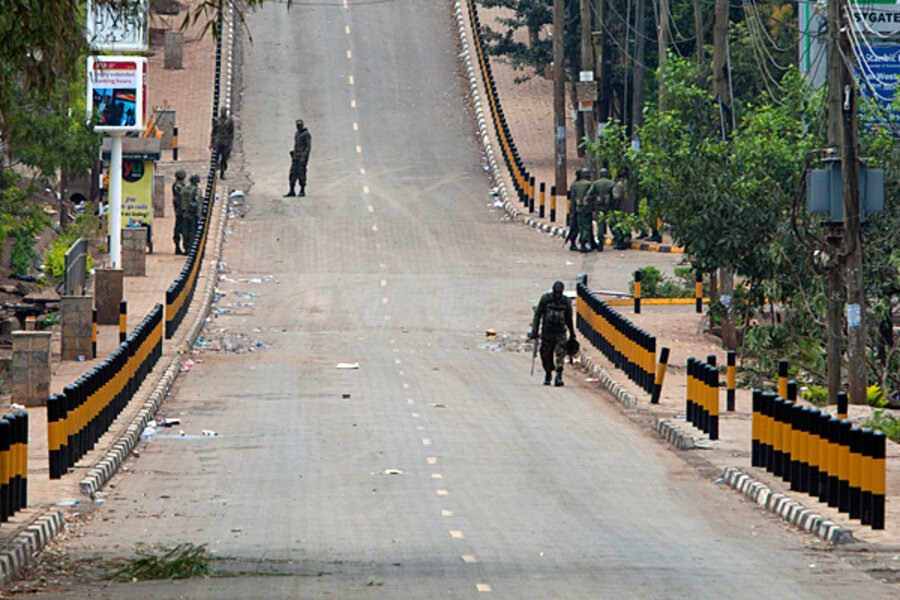Kenya info blackout? Extraordinary lack of detail about Westgate siege.
| Nairobi, Kenya
Even as President Uhuru Kenyatta was giving his televised address on Tuesday, telling the world that the siege of Nairobi’s Westgate mall was over, Kenya’s "netizens" were celebrating.
With the hashtag #WeAreOne, praise for President Kenyatta, the Kenya Defense Forces, the police and the Red Cross swamped Twitter and other social media, as did elegies for the 61 civilians and six security officers the president said to have died during the assault.
Soon, however, the tone had noticeably hardened: “SO. MANY. QUESTIONS” tweeted @kenyanpundit. In another, Kenyan authorities had “not provided a single mugshot of the attackers,” as @bonifacemwangi tweeted.
By Wednesday, a list of 85 questions drawn up by Kenyan citizens was doing the rounds online, demanding answers from their government that was either unable or unwilling to clarify fundamental aspects of the 80-hour ordeal.
During the Tuesday speech, Kenyatta did not clarify the final number of people who died. He said 61 civilians, six troops and five attackers were dead but did not spell out if that was in addition to a Kenya Red Cross toll of 62 already counted fatalities.
A further 71 people are registered missing, the charity said Wednesday.
More bodies, including those of the militants, were buried in rubble where a portion of the Westgate Shopping Mall collapsed in the last hours of the siege, Kenyatta said. But he was unable to say how many attackers there were, or how they ferried apparently large amounts of ammunition or conspicuously heavy weapons into the four-story mall.
Perhaps most disturbingly for those still waiting for news of missing loved ones, he did not mention the word “hostage” once in his 15-minute address.
Early reports from the mall siege gave the impression that there were perhaps dozens of people being held after the first waves of hundreds who managed to escape as the attackers took over the complex.
The Kenya Red Cross established an emergency field hospital in the basement car park of a Hindu community hall, to “be prepared for many injured”, according to Rashmi Shah, one of the center's managers.
In the event, fewer than 10 people were treated there, and most of those were soldiers. By Tuesday, the triage hospital unit was shut.
Now among the most urgent questions that has been raised: “Where are the hostages?”
Critics are raising allegations against national intelligence and security forces of how such a heavily armed band of foreigners was allowed to enter Kenya, and then to transfer their arsenal into the guarded mall.
"My position, and the police will investigate this, is that there was a very serious lapse in security, which may have gone on for six months,” said Laban Onditi Rao, vice-chairman of the Kenyan National Chamber of Commerce, who was communicating with the mall's owners and security staff during the siege.
"There is the idea that they hired a shop there, and that would give them accessibility all over the mall, and would allow some of them to pass security easily because they would be known," he said.
Responding to this, Manoah Esipisu, Kenya’s presidential spokesman, said late Tuesday that, “we’re leaving nothing to chance" in the investigation, including whether the militant gang had rented a shop at Westgate, or that they had an insider helping them.
As demands for answers to still unexplained aspects of the assault grew on Wednesday, Mr. Esipisu’s phone was switched off.
One Kenyatta administration official said that “there seems to be a shutdown of information” within the government, and no real details are getting out to its citizens. The official requested anonymity to speak candidly about internal government operations.
Meanwhile, US, Israeli and British forensics experts were preparing to enter the mall to help Kenyan authorities assess what is now a vast crime scene. It is expected that their inquiries will continue for at least a week.
“We will provide additional assistance in the coming days to investigate this attack and to bring its organizers and perpetrators to justice,” said Robert Godec, the US ambassador to Kenya. “We will continue to work together with Kenya to stop the scourge of terrorism.”
Kenyatta said that “we cannot confirm the details at present” of reports that two American citizens and a Briton were among the attackers.
By the end of Wednesday in Nairobi, a new hashtag had emerged, #WeAreOne_dering.








